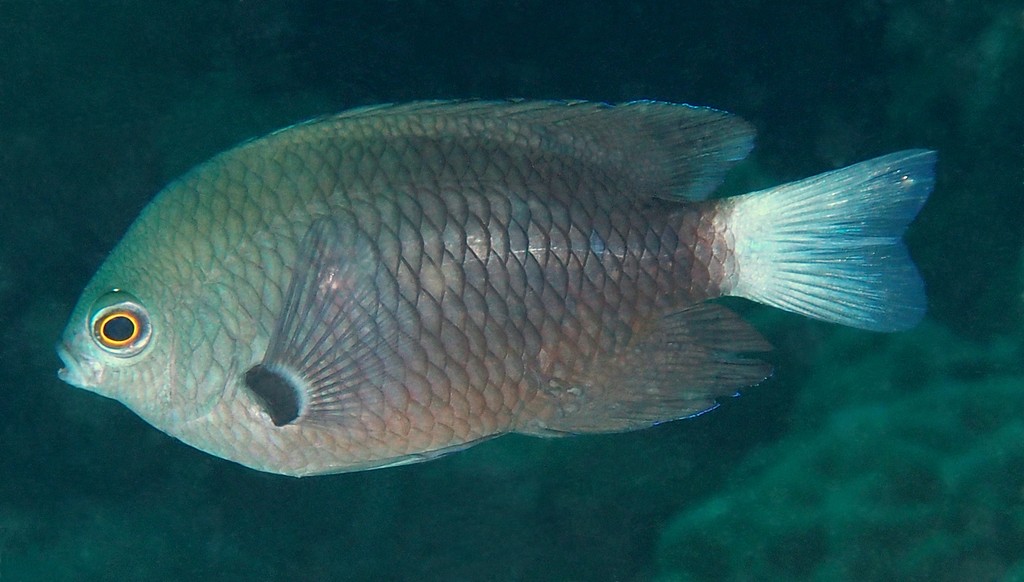POMACENTRUS NAGASAKIENSIS - (TANAKA, 1917)
Actinopterygii (Gigaclass) > Actinopteri (Class) > Teleostei (Subclass) > Blenniiformes (Order) > Pomacentridae (Family) > Pomacentrinae (Subfamily) > Pomacentrus (Genus)
Blue-scribbled damsel, Blue-scribbled damselfish, Nagasaki damsel, Nagasaki damselfish, Sandy damsel, Speckled-fin damsel, Nagasaki-suzumedai, ナガサキスズメダイ, 나가사끼자리돔, 长崎雀鲷, 長崎雀鯛,
Synonymes
Pomacentrus arenarius (Allen, 1987)
Pomacentrus caudovittatus (Schmidt, 1931)
--------------------------
Description
Dorsal spines (total): 13; Dorsal soft rays (total): 14-15; Anal spines: 2; Anal soft rays: 16-17; Pectoral fin rays: 17-18; Lateral line scales: 17-19; Body depth: 1.9-2.2 in SL; Gill rakers: 18-21; Body ovate, compressed. Posterior margin of preopercle serrate. Suborbital naked, with serrate ventral margin. Teeth on jaws biserial, incisorlike. Caudal fin slightly emarginate; No conspicuous projecting spine-like rays at upper and lower edges of caudal fin base. Max. length: 11.0 cm TL. Depth range: 3 - 60 m, usually: 5 - 35 m.
Color
Juveniles: mainly blue, with large ocellus on dorsal fin rays.
Adults: Body dark grey or bluish grey, with blackish scale margins forming network pattern; Head slightly paler with many blue lines and spots; Large black spot covering pectoral fin bases; Fins mostly grey to translucent bluish, with series of diffuse darker bands across caudal fin and dorsal- and anal fin rays, and dorsal fin with series of black spots at spine tips.
Etymology
Pomacentrus: from Greek, poma, -atos = cover, operculum + from Greek, kentron = something with a sharp point: point, spike, spur, sting, quill, thorn. Referring to serrations and prickles along margins of opercular bones of Pomacentrus pavo.
nagasakiensis: from Nagasaki the type locality in Japan.
Original description: Pomacentrus nagasakiensis Tanaka, 1917 - Type locality: fish market in Nagasaki, Japan.
Distribution
Indo-West Pacific: Maldives and Sri Lanka, east to Palau and New Ireland (Papua New Guinea), north to Korea, central Japan and Ogasawara Islands (Japan), south to Point Quobba (Western Australia), Sydney (New South Wales, Australia) and New Caledonia.
Biology
Adults are found in sandy areas of both lagoon and seaward reefs. They occur in small groups with outcrops of soft coral patches or gorgonians. Feed primarily on zooplankton. Oviparous, males guard the nest. Eggs are demersal and adhere to the substrate. Courtship behavior during breeding includes signal jumps, enticement, chasing and skimming.
Similar species
Pomacentrus flavioculus (Allen, Erdmann & Pertiwi, 2017) - Reported from South Pacific: Fiji and Tonga.
Pomacentrus imitator (Whitley, 1964) - Reported from New Caledonia.
Pomacentrus limosus (Allen, 1992) - Reported from Eastern Indian Ocean: Churchill Reef (Western Australia).
Last update: 10, July 2024
Blue-scribbled damsel, Blue-scribbled damselfish, Nagasaki damsel, Nagasaki damselfish, Sandy damsel, Speckled-fin damsel, Nagasaki-suzumedai, ナガサキスズメダイ, 나가사끼자리돔, 长崎雀鲷, 長崎雀鯛,
Synonymes
Pomacentrus arenarius (Allen, 1987)
Pomacentrus caudovittatus (Schmidt, 1931)
--------------------------
Description
Dorsal spines (total): 13; Dorsal soft rays (total): 14-15; Anal spines: 2; Anal soft rays: 16-17; Pectoral fin rays: 17-18; Lateral line scales: 17-19; Body depth: 1.9-2.2 in SL; Gill rakers: 18-21; Body ovate, compressed. Posterior margin of preopercle serrate. Suborbital naked, with serrate ventral margin. Teeth on jaws biserial, incisorlike. Caudal fin slightly emarginate; No conspicuous projecting spine-like rays at upper and lower edges of caudal fin base. Max. length: 11.0 cm TL. Depth range: 3 - 60 m, usually: 5 - 35 m.
Color
Juveniles: mainly blue, with large ocellus on dorsal fin rays.
Adults: Body dark grey or bluish grey, with blackish scale margins forming network pattern; Head slightly paler with many blue lines and spots; Large black spot covering pectoral fin bases; Fins mostly grey to translucent bluish, with series of diffuse darker bands across caudal fin and dorsal- and anal fin rays, and dorsal fin with series of black spots at spine tips.
Etymology
Pomacentrus: from Greek, poma, -atos = cover, operculum + from Greek, kentron = something with a sharp point: point, spike, spur, sting, quill, thorn. Referring to serrations and prickles along margins of opercular bones of Pomacentrus pavo.
nagasakiensis: from Nagasaki the type locality in Japan.
Original description: Pomacentrus nagasakiensis Tanaka, 1917 - Type locality: fish market in Nagasaki, Japan.
Distribution
Indo-West Pacific: Maldives and Sri Lanka, east to Palau and New Ireland (Papua New Guinea), north to Korea, central Japan and Ogasawara Islands (Japan), south to Point Quobba (Western Australia), Sydney (New South Wales, Australia) and New Caledonia.
Biology
Adults are found in sandy areas of both lagoon and seaward reefs. They occur in small groups with outcrops of soft coral patches or gorgonians. Feed primarily on zooplankton. Oviparous, males guard the nest. Eggs are demersal and adhere to the substrate. Courtship behavior during breeding includes signal jumps, enticement, chasing and skimming.
Similar species
Pomacentrus flavioculus (Allen, Erdmann & Pertiwi, 2017) - Reported from South Pacific: Fiji and Tonga.
Pomacentrus imitator (Whitley, 1964) - Reported from New Caledonia.
Pomacentrus limosus (Allen, 1992) - Reported from Eastern Indian Ocean: Churchill Reef (Western Australia).
Last update: 10, July 2024
